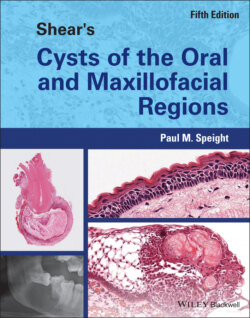Читать книгу Shear's Cysts of the Oral and Maxillofacial Regions - Paul M. Speight - Страница 68
Site
ОглавлениеInflammatory collateral cysts are almost exclusively found in the mandible and over 60% are paradental cysts involving a mandibular third molar. Only a handful of cases have been reported in the maxilla. In the original description of the lesion, Main (1970 ) described 1 case associated with an upper canine and Vedtofte and Holmstrup (1989 ) subsequently reported a series of 8 cases arising between the upper canine and second incisor (globulomaxillary region). In their large review, Philipsen et al. (2004 ) found that 97.3% of cases arose in the mandible, with only 10 (2.7%: including the 8 cases of Vedtofte and Holmstrup) in the maxilla. Jones et al. (2006 ) found 402 inflammatory collateral cysts in their files, but only 1 case was recorded in the maxilla, associated with a third molar. Ochsenius et al. (2007 ) found 113 paradental cysts in their series of odontogenic cysts, 6 (5.3%) of which were associated with maxillary third molars. The 4 premolar cases reported by Morimoto et al. (2004 ) were all in the mandible.
Paradental cysts are located almost exclusively on mandibular third molars, but 2 cases have been recorded on second molars when the third molar is absent and the second molar is the last standing tooth (see later Figure 4.2; Vedtofte and Praetorius 1989 ; de Sousa et al. 2001 [2 cases]; Maruyama et al. 2015 ). These unusual examples arose at an average age of 14.5 years (range 13–17 years), but were otherwise identical to paradental cysts encountered on third molars.
Mandibular buccal bifurcation cysts are located on the first or second molar teeth, but the relative frequency of occurrence on each tooth is rarely reported. In the review by Philipsen et al. (2004 ), cysts on the first and second molars were usually reported together, but for 49 cases the site distribution was known. Of these cases, 36 (73.5%) were located on first molars and 13 (26.5%) on second molars. This suggests that mandibular buccal bifurcation cysts are about twice as common on first molars as on second molars.
Inflammatory collateral cysts may be bilateral, but this is more common for the mandibular buccal bifurcation cyst than for paradental cysts. Case series have shown that between about 16 and 40% of mandibular buccal bifurcation cysts present as bilateral lesions (Table 4.3), while bilateral lesions are only seen in about 4% of patients with paradental cysts (Table 4.2)
